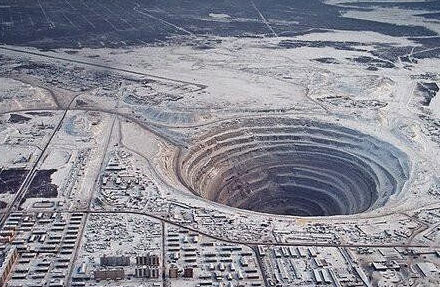(单词翻译:单击)
Four years later, Soviet scientists decided to try their luck on dry land. They chose a spot on Russia's Kola Peninsula, near the Finnish border, and set to work with the hope of drilling to a depth of fifteen kilometers. The work proved harder than expected, but the Soviets were commendably persistent. When at last they gave up, nineteen years later, they had drilled to a depth of 12,262 meters, or about 7.6 miles. Bearing in mind that the crust of the Earth represents only about 0.3 percent of the planet's volume and that the Kola hole had not cut even one-third of the way through the crust, we can hardly claim to have conquered the interior.
4年以后,苏联科学家决定在陆地上碰碰运气。他们说干就干,在俄罗斯的科拉半岛离芬兰边境不远的地方选了个点,希望能钻到15公里的深度。这项工作比预期的还要艰苦,但苏联人有着值得称道的韧劲儿。到19年以后他们终于放弃的时候,他们已经钻到了12262米的深度。但是,我们没有忘记,地壳只代表地球大约0.3%的体积,科拉钻探还没有深入到地壳的三分之一,因此我们几乎无法声称已经征服了地球内部。
Interestingly, even though the hole was modest, nearly everything about it was surprising. Seismic wave studies had led the scientists to predict, and pretty confidently, that they would encounter sedimentary rock to a depth of 4,700 meters, followed by granite for the next 2,300 meters and basalt from there on down. In the event, the sedimentary layer was 50 percent deeper than expected and the basaltic layer was never found at all. Moreover, the world down there was far warmer than anyone had expected, with a temperature at 10,000 meters of 180 degrees centigrade, nearly twice the forecasted level. Most surprising of all was that the rock at that depth was saturated with water—something that had not been thought possible.
虽然这次钻探的深度有限,但所发现的一切几乎都令研究人员感到意外。地震波研究一直使科学家们预言,而且是很有把握地预言,他们会在4700米深处碰到沉积岩,接着往下是2300米厚的花岗岩,再往下是玄武岩。结果发现,沉积岩层要比预期的厚50%,而玄武岩层根本没有发现。而且,地下世界要比预期的暖和得多,1万米深处的温度高达180摄氏度,差不多是预期的两倍。最令人吃惊的是深处的岩石浸透了水——这一直被认为是不可能的事。


